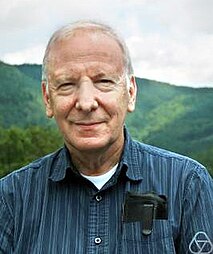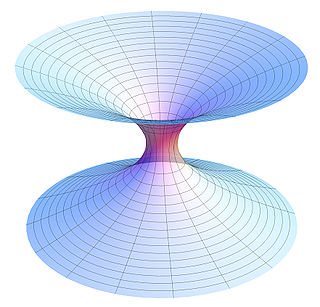External links
- Sorkin's homepage at the Perimeter Institute
- Sorkin's preprints at arXiv
- Geometry from order: causal sets
- Non-technical text by Sorkin on Einstein Online.
Rafael Dolnick Sorkin (born c. 1945) is an American physicist. He is professor emeritus of physics at Syracuse University and the Perimeter Institute for Theoretical Physics, and a Fellow of the American Physical Society. He is best known as initiator and main proponent of the causal sets approach to quantum gravity.
Sorkin grew up in Chicago, Illinois, and was educated at the New Trier Township High School (valedictorian, 1963), Harvard University (A.B., Summa Cum Laude, Phi Beta Kappa, 1966), and California Institute of Technology (Ph.D., 1974). He is the son of the American violinist Leonard Sorkin.
Sorkin believes that the successful solution of quantum gravity will involve both a reevaluation of gravity in terms of a discrete structure underlying continuous spacetime, and also a reformulation of quantum mechanics. He also hypothesises that the phenomena of topology change and the thermodynamics of the black hole structure provide important clues to the formation of the final synthesis. In this framework he has examined the quantum properties of topological geons (particles created directly from the spacetime topology). His findings include that the topological geons can exhibit remarkable statistical properties. He also discovered evidence that topology change is a required feature of any consistent quantum gravity theory. He has hunted the origin of a black hole's entropy to discover more about how it relates to the synthesis of quantum mechanics and the theory of general relativity.
He also introduced anhomomorphic logic, a new interpretation of quantum theory.

General relativity, also known as the general theory of relativity, is the geometric theory of gravitation published by Albert Einstein in 1915 and is the current description of gravitation in modern physics. General relativity generalizes special relativity and refines Newton's law of universal gravitation, providing a unified description of gravity as a geometric property of space and time or four-dimensional spacetime. In particular, the curvature of spacetime is directly related to the energy and momentum of whatever matter and radiation are present. The relation is specified by the Einstein field equations, a system of partial differential equations.
Quantum gravity (QG) is a field of theoretical physics that seeks to describe gravity according to the principles of quantum mechanics, and where quantum effects cannot be ignored, such as in the vicinity of black holes or similar compact astrophysical objects where the effects of gravity are strong, such as neutron stars.

In physics, string theory is a theoretical framework in which the point-like particles of particle physics are replaced by one-dimensional objects called strings. String theory describes how these strings propagate through space and interact with each other. On distance scales larger than the string scale, a string looks just like an ordinary particle, with its mass, charge, and other properties determined by the vibrational state of the string. In string theory, one of the many vibrational states of the string corresponds to the graviton, a quantum mechanical particle that carries gravitational force. Thus string theory is a theory of quantum gravity.

A theory of everything, final theory, ultimate theory, or master theory is a hypothetical, singular, all-encompassing, coherent theoretical framework of physics that fully explains and links together all physical aspects of the universe. Finding a TOE is one of the major unsolved problems in physics. String theory and M-theory have been proposed as theories of everything. Over the past few centuries, two theoretical frameworks have been developed that, together, most closely resemble a TOE. These two theories upon which all modern physics rests are general relativity and quantum mechanics. General relativity is a theoretical framework that only focuses on gravity for understanding the universe in regions of both large scale and high mass: stars, galaxies, clusters of galaxies etc. On the other hand, quantum mechanics is a theoretical framework that only focuses on three non-gravitational forces for understanding the universe in regions of both small scale and low mass: sub-atomic particles, atoms, molecules, etc. Quantum mechanics successfully implemented the Standard Model that describes the three non-gravitational forces – strong nuclear, weak nuclear, and electromagnetic force – as well as all observed elementary particles.
Causality is the relationship between causes and effects. While causality is also a topic studied from the perspectives of philosophy, from the perspective of physics, it is operationalized so that causes of an event must be in the past light cone of the event and ultimately reducible to fundamental interactions. Similarly, a cause cannot have an effect outside its future light cone.
Lee Smolin is an American theoretical physicist, a faculty member at the Perimeter Institute for Theoretical Physics, an adjunct professor of physics at the University of Waterloo and a member of the graduate faculty of the philosophy department at the University of Toronto. Smolin's 2006 book The Trouble with Physics criticized string theory as a viable scientific theory. He has made contributions to quantum gravity theory, in particular the approach known as loop quantum gravity. He advocates that the two primary approaches to quantum gravity, loop quantum gravity and string theory, can be reconciled as different aspects of the same underlying theory. His research interests also include cosmology, elementary particle theory, the foundations of quantum mechanics, and theoretical biology.
Benjamin "Ben" Schumacher is an American theoretical physicist, working mostly in the field of quantum information theory.

Fotini G. Markopoulou-Kalamara is a Greek theoretical physicist interested in quantum gravity, foundational mathematics and quantum mechanics and a design engineer working on embodied cognition technologies. Markopoulou is co-founder and CEO of Empathic Technologies. She was a founding faculty member at Perimeter Institute for Theoretical Physics and was an adjunct professor at the University of Waterloo.
Quantum foam is the quantum fluctuation of spacetime on very small scales due to quantum mechanics. Matter and antimatter is constantly created from nothing and destructed into nothing. These subatomic objects are called virtual particles, also called quantum foam. The idea was devised by John Wheeler in 1955.
Background independence is a condition in theoretical physics, that requires the defining equations of a theory to be independent of the actual shape of the spacetime and the value of various fields within the spacetime. In particular this means that it must be possible not to refer to a specific coordinate system—the theory must be coordinate-free. In addition, the different spacetime configurations should be obtained as different solutions of the underlying equations.

James Burkett Hartle is an American physicist. He has been a professor of physics at the University of California, Santa Barbara since 1966, and he is currently a member of the external faculty of the Santa Fe Institute. Hartle is known for his work in general relativity, astrophysics, and interpretation of quantum mechanics.
In physics, there is a speculative hypothesis that if there were a black hole with the same mass, charge and angular momentum as an electron, it would share other properties of the electron. Most notably, Brandon Carter showed in 1968 that the magnetic moment of such an object would match that of an electron. This is interesting because calculations ignoring special relativity and treating the electron as a small rotating sphere of charge give a magnetic moment that is off by roughly a factor of 2, the so-called gyromagnetic ratio.

Causal dynamical triangulation theorized by Renate Loll, Jan Ambjørn and Jerzy Jurkiewicz, is an approach to quantum gravity that like loop quantum gravity is background independent.

In theoretical physics, topological string theory is a version of string theory. Topological string theory appeared in papers by theoretical physicists, such as Edward Witten and Cumrun Vafa, by analogy with Witten's earlier idea of topological quantum field theory.

Robert M. Wald is an American theoretical physicist who studies gravitation. His research interests include general relativity, black holes, and quantum gravity. He is also a science communicator and textbook author.

The causal sets program is an approach to quantum gravity. Its founding principles are that spacetime is fundamentally discrete and that spacetime events are related by a partial order. This partial order has the physical meaning of the causality relations between spacetime events.
The following outline is provided as an overview of and topical guide to black holes:
In physics, a pregeometry is a structure from which the geometry of the universe develops. Some cosmological models feature a pregeometric universe before the Big Bang. The term was championed by John Archibald Wheeler in the 1960s and 1970s as a possible route to a theory of quantum gravity. Since quantum mechanics allowed a metric to fluctuate, it was argued that the merging of gravity with quantum mechanics required a set of more fundamental rules regarding connectivity that were independent of topology and dimensionality. Where geometry could describe the properties of a known surface, the physics of a hypothetical region with predefined properties, "pregeometry" might allow one to work with deeper underlying rules of physics that were not so strongly dependent on simplified classical assumptions about the properties of space.

Theoretical physics is a branch of physics that employs mathematical models and abstractions of physical objects and systems to rationalize, explain and predict natural phenomena. This is in contrast to experimental physics, which uses experimental tools to probe these phenomena.
In theoretical physics, the problem of time is a conceptual conflict between general relativity and quantum mechanics in that quantum mechanics regards the flow of time as universal and absolute, whereas general relativity regards the flow of time as malleable and relative. This problem raises the question of what time really is in a physical sense and whether it is truly a real, distinct phenomenon. It also involves the related question of why time seems to flow in a single direction, despite the fact that no known physical laws at the microscopic level seem to require a single direction. For macroscopic systems the directionality of time is directly linked to first principles such as the Second law of thermodynamics.